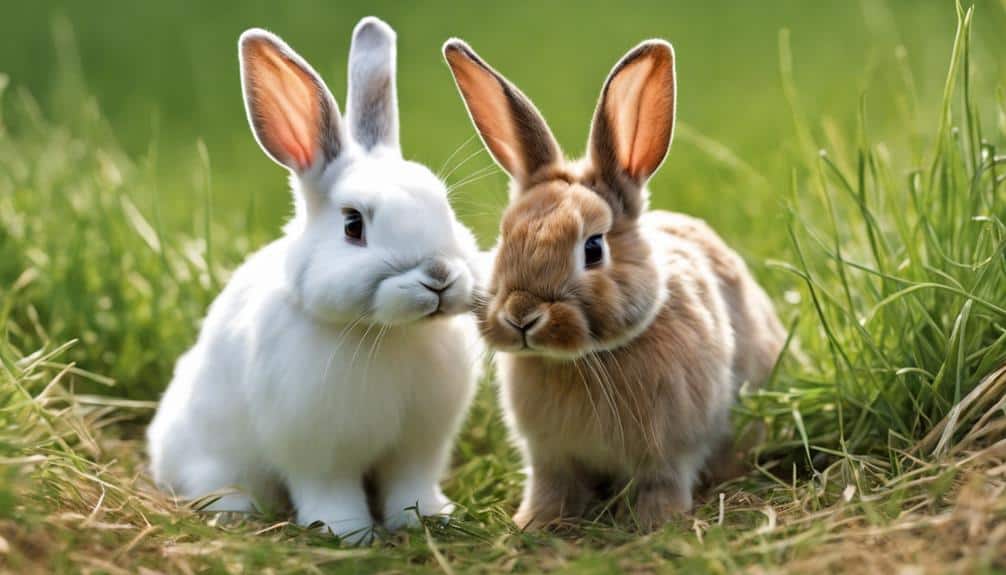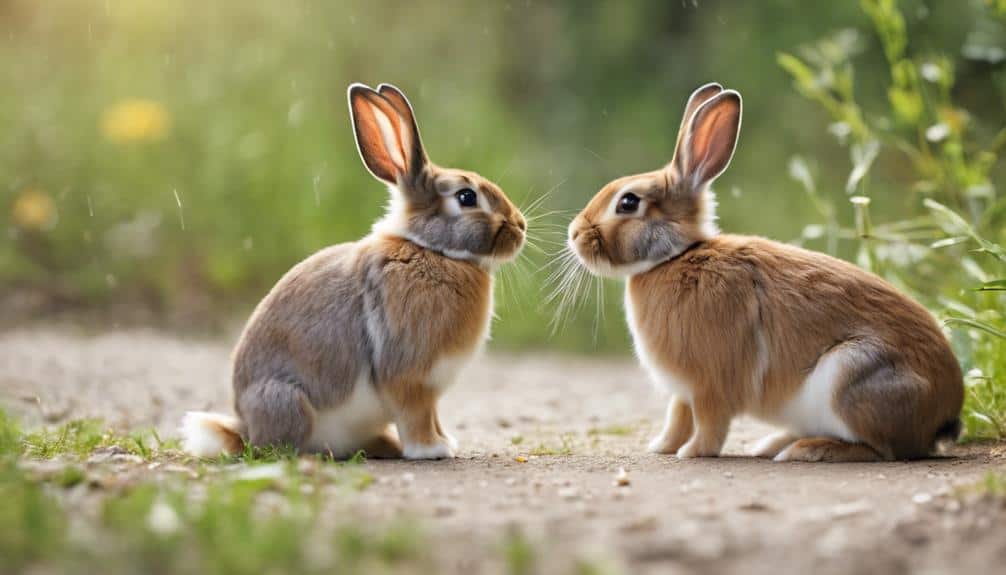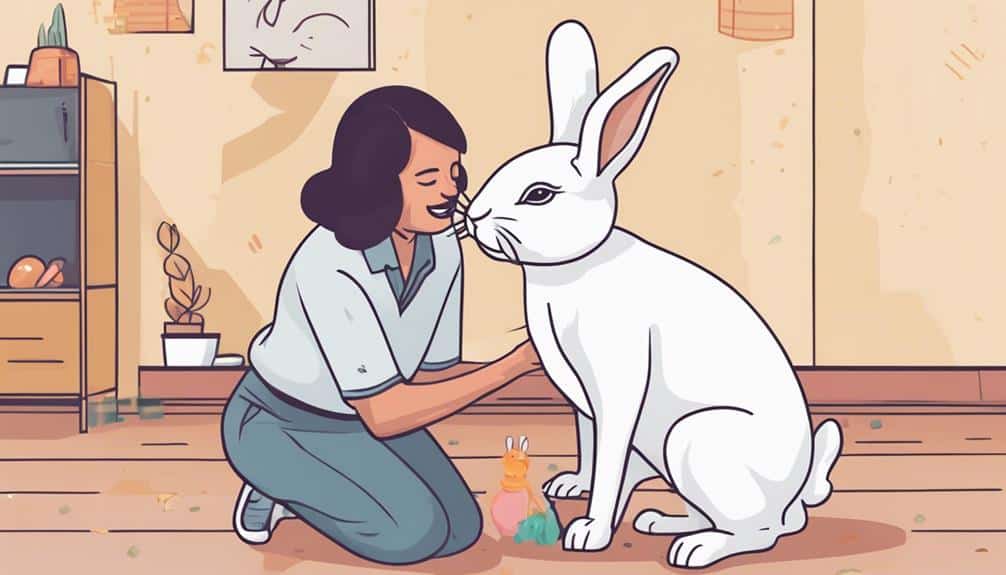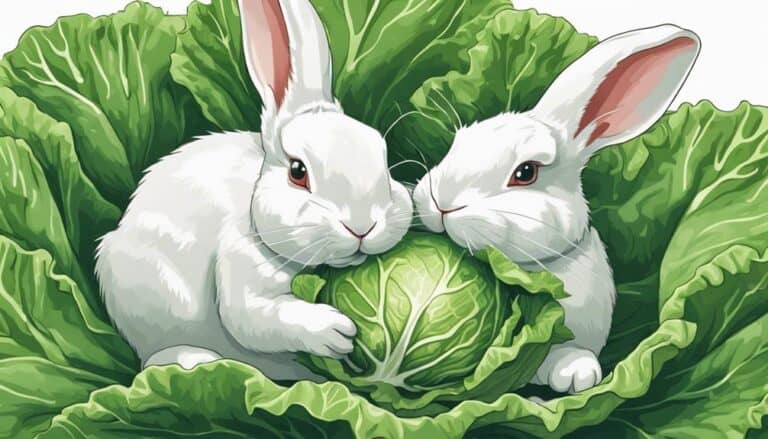Imagine walking into your backyard to find your two pet bunnies engaging in what appears to be a rather intimate activity.
You may be wondering, do bunnies hump as a normal behavior, or is there more to it than meets the eye?
Understanding the complexities of bunny humping can shed light on the intricacies of rabbit behavior and communication.
Contents
- 1 Key Takeaways
- 2 Reasons for Bunny Humping
- 3 Normalcy of Bunny Humping
- 4 Addressing Bunny Humping Behavior
- 5 Impact of Bunny Humping on Health
- 6 Bunny Humping and Bonding
- 7 Gender Dynamics in Bunny Humping
- 8 Managing Bunny Humping in Pairs
- 9 Training Techniques for Bunny Humping
- 10 Bunny Humping FAQs
- 11 Frequently Asked Questions
- 12 Conclusion
Key Takeaways
- Bunny humping is a normal part of social interactions and communication among rabbits.
- Humping behavior can stem from dominance, playfulness, or hormonal imbalances.
- Neutering and bonding help manage humping tendencies effectively.
- Understanding the reasons behind humping aids in addressing and preventing excessive behavior.
Reasons for Bunny Humping

Bunny humping occurs for various reasons, primarily linked to dominance or playfulness within their social interactions. Female rabbits may exhibit humping behavior as a way to establish hierarchy among themselves. Additionally, female rabbits might hump due to phantom pregnancies, where they display nesting behaviors even though they aren't pregnant. Neutered male rabbits may also hump objects out of sexual aggression, a behavior that can be reduced through the neutering process.
It is essential to understand that humping behavior in rabbits is a normal part of their social dynamics and not considered abusive or harmful. Neutering and providing a suitable partner for bonding can help address humping behaviors in rabbits effectively. By promoting spaying and neutering practices and encouraging social interactions between rabbits, you can help create a harmonious environment for these animals to express their natural behaviors in a healthy way.
Normalcy of Bunny Humping
Humping behavior in rabbits serves as a common social mechanism for establishing hierarchy and communicating dominance within their group. Female rabbits, just like males, may exhibit humping behavior. Here are some key points to help you understand the normalcy of bunny humping:
- Dominant Rabbit Behavior: Dominant rabbits often hump to assert their position within the group.
- Female Rabbit Humping: Female rabbits can also hump, sometimes due to hormonal responses like phantom pregnancies.
- Social Communication: Humping is a way for rabbits to communicate dominance and maintain order in their social structure.
- Non-Abusive Behavior: In the rabbit world, humping is a natural behavior and isn't considered abusive or harmful.
Understanding these aspects of bunny humping can help you appreciate it as a normal part of rabbit social interaction. If you observe humping behavior in your rabbits, remember that proper management techniques, such as neutering and socialization, can help address any potential issues.
Addressing Bunny Humping Behavior

When addressing bunny humping behavior, it's crucial to ponder the underlying reasons behind this natural behavior. Understanding bunny mating behavior, the motivations for humping, and effective ways to manage it can help create a harmonious environment for your rabbits.
Bunny Mating Behavior
While observing rabbit behavior, it becomes evident that mounting actions serve various social and reproductive purposes within their interactions.
- Bunny humping behavior can be a form of communication, playfulness, or dominance display.
- Mounting is common between same-sex or neutered rabbits and serves social bonding purposes.
- In reproductively active pairs, humping behavior facilitates mating.
- Observing rabbits before, during, and after mounting can reveal the guarantee for intervention.
Understanding these aspects of bunny mating behavior can help guarantee the well-being and harmony of your rabbits. By recognizing the different reasons behind humping, you can better address any concerns that may arise and provide appropriate care for your furry companions.
Reasons for Bunny Humping
To understand the reasons behind bunny humping behavior, it is essential to recognize that this action can serve as a form of communication, dominance display, or social interaction among rabbits. Neutered rabbits may still exhibit humping behavior, which is often a way to establish dominance or communicate. Below is a table highlighting key points related to bunny humping behavior:
| Bunny Humping Behavior | Facts |
|---|---|
| Dominance Display | Typically seen in unneutered males exhibiting sexual aggression. |
| Social Interaction | Can be a way for rabbits to bond with a partner or establish hierarchy. |
| Hormonal Influences | Imbalances can contribute to humping behavior even in desexed rabbits. |
| Veterinary Diagnosis | Vets can identify underlying causes like undescended testicles through blood work. |
| Addressing Behavior | Neutering and bonding with another rabbit are vital in managing humping tendencies. |
Understanding these factors can help caretakers address and manage bunny humping behavior effectively.
Managing Bunny Humping
Neutering or spaying rabbits is a key approach to reducing humping behavior by regulating hormones effectively.
To manage rabbit humping behavior, consider the following tips:
- Provide environmental enrichment: Utilize toys and tunnels to redirect your rabbits' attention from humping.
- Consult with a knowledgeable veterinarian: Seek guidance from a vet experienced in rabbit care to help manage humping behavior effectively.
- Increase social interaction: Offer more social interaction and gentle petting to address any underlying causes of humping.
- Consider blood work: Blood tests can assess hormone levels and identify any hormonal imbalances contributing to humping.
Impact of Bunny Humping on Health

Bunny humping can have detrimental effects on the health and well-being of rabbits, including stress, physical discomfort, and social conflicts. Excessive rabbit humping, often associated with dominance behavior, can lead to stress and anxiety in the rabbit being mounted. This behavior can cause physical discomfort and potential injuries, especially if one rabbit is notably larger or more forceful than the other. Additionally, continuous mounting may indicate underlying dominance issues within a pair or group of rabbits, disrupting their bond and leading to social conflicts.
It is important to monitor and address bunny humping behavior to guarantee the well-being and harmony of pet rabbits. By understanding the implications of this behavior on their health, you can take proactive steps to manage and prevent excessive humping. Providing a safe and comfortable environment, along with proper socialization and enrichment, can help alleviate stress and reduce the occurrence of mounting behavior among rabbits.
Bunny Humping and Bonding
When observing rabbit behavior, it's essential to understand the significance of humping as a natural form of communication and bonding between these animals. Rabbit humping serves various purposes beyond mere dominance, including establishing social hierarchy and strengthening relationships. Here are some key points to take into account:
- Communication: Rabbit humping can be a way for these animals to convey messages to each other, such as establishing boundaries or expressing affection.
- Bonding: Engaging in humping behavior can help rabbits build and reinforce social bonds within a group, creating a sense of unity and cooperation.
- Social Dynamics: Monitoring humping interactions can provide valuable insights into the relationships between rabbits, shedding light on their social structure and dynamics.
- Neutered or Spayed Rabbits: Even after being sterilized, rabbits may continue to hump as a way to interact socially, emphasizing the non-sexual nature of this behavior.
Understanding the role of humping in rabbit behavior can help owners support their pets' social interactions and overall well-being.
Gender Dynamics in Bunny Humping
Female rabbits may engage in humping behavior as a means to establish dominance within their social hierarchy. This behavior can be a display of territorial or dominant tendencies, helping them assert themselves in their environment.
Understanding these gender dynamics in bunny humping is important for effectively managing their behavior and ensuring their overall well-being.
Bunny Dominance in Humping
In establishing hierarchy within a rabbit group, dominance is often demonstrated through humping behavior, regardless of the rabbits' genders. Female rabbits can exhibit dominance behavior by humping other rabbits or objects to display superiority or establish territory.
Neutering is a helpful intervention to reduce dominance-related humping in both male and female rabbits. Understanding the dynamics of dominance in bunny humping can aid in managing social interactions and behavior effectively.
- Female rabbits display dominance through humping.
- Neutering can decrease dominance-related humping behaviors.
- Humping can be a way for rabbits to establish territory.
- Understanding dominance in humping helps in managing social interactions.
Social Hierarchy Implications
Establishing social hierarchy among rabbits involves utilizing humping behavior as a communication tool for asserting dominance within their group. Dominant rabbits, regardless of gender, may engage in humping to establish their position within the social order.
Female rabbits, in particular, can exhibit humping behavior during territorial disputes to assert dominance over others. This dominance behavior isn't solely linked to sexual activity but serves as a means of communication for establishing social order within the group.
By observing these interactions, one can gain insights into the gender dynamics in bunny humping and better understand the hierarchy and social interactions within a rabbit community.
Recognizing the significance of dominance behavior and territorial marking in rabbit behavior can provide valuable information on their social structure and interactions.
Managing Bunny Humping in Pairs
When managing bunny humping in pairs, observing rabbits' behavior before, during, and after mounting can provide valuable insights into their interactions. By paying attention to how the rabbits behave, you can better understand the dynamics between them and determine if any intervention is necessary.
Here are some tips to help you manage bunny humping effectively:
- Providing hiding spots for the submissive rabbit can help prevent discomfort during humping.
- Separating rabbits during times when humping is likely to occur can reduce mounting frequency.
- Avoiding aversive methods like shouting or spraying water is recommended to address humping behavior.
- Focusing on building trust and understanding the rabbits' behavior is key to effectively managing humping in pairs.
Training Techniques for Bunny Humping

To effectively address bunny humping behavior, utilize positive reinforcement techniques like treats and praise to redirect the behavior towards more crucial activities. When your rabbit engages in humping, calmly redirect their attention by offering a favorite treat or engaging them in a different activity. Providing alternative outlets for their energy, such as toys and tunnels, can help keep your bunny occupied and less likely to hump. Remember to avoid scolding or yelling at your rabbit, as this can lead to increased stress and anxiety, potentially exacerbating the humping behavior.
For more tailored guidance, consider seeking advice from a rabbit behavior specialist who can offer personalized training techniques to address humping in your bunny. Consistency and patience are crucial when implementing these strategies, as behavior change takes time. By using positive reinforcement, offering engaging activities, and seeking expert advice when needed, you can effectively train your rabbit to redirect their humping behavior towards more suitable actions.
Bunny Humping FAQs
Bunny humping behavior is a common occurrence among rabbits, serving various purposes such as dominance display and communication. If you're wondering about this behavior, here are some frequently asked questions to help you better understand bunny humping:
- Why do female rabbits hump? Female rabbits may hump to establish hierarchy within a group or due to phantom pregnancies.
- What about male rabbits? Unneutered bucks or solitary bucks may hump objects out of sexual aggression or to mark territory.
- Is humping behavior harmful? Humping behavior in rabbits isn't considered harmful or abusive. It's a natural behavior for them.
- How can you address humping behavior? Neutering your rabbit and providing them with a bonded partner can help reduce humping behavior, especially in males.
Frequently Asked Questions
Should I Let My Rabbit Hump?
You should establish clear behavioral boundaries with your rabbit. Encourage healthy alternatives to humping, like providing more space or toys. Monitor interactions closely to guarantee safety. Understanding the reasons behind the behavior can guide your approach.
Do Bunnies Still Hump After Being Neutered?
After being neutered, bunnies may still display humping behavior. This can stem from residual instincts or dominance issues. Encourage positive behavior changes through enriching their environment and fostering social interaction for better bonding. Veterinary guidance is advised.
Why Is My Female Rabbit Trying to Hump My Cat?
When your female rabbit tries to hump your cat, it's likely about animal behavior and dominance hierarchy. Interspecies interactions can involve complex social dynamics. Spaying your rabbit can help manage territorial aggression and promote harmonious relationships among your pets.
Why Is My Rabbit Climbing My Leg?
Sometimes, your rabbit climbs your leg seeking attention or asserting dominance. Redirect this behavior with behavioral training and bonding exercises. Understanding your rabbit's cues can help improve your relationship and minimize leg climbing.
Conclusion
In summary, understanding why bunnies hump is key to managing their behavior and promoting their well-being.
Like two dancers in perfect synchrony, rabbits use humping to communicate, bond, and establish social order.
By addressing this behavior with proper care, enrichment, and spaying/neutering, you can make sure a harmonious and healthy environment for your furry friends.
Stay informed, stay observant, and watch your bunnies thrive like a well-choreographed performance.






